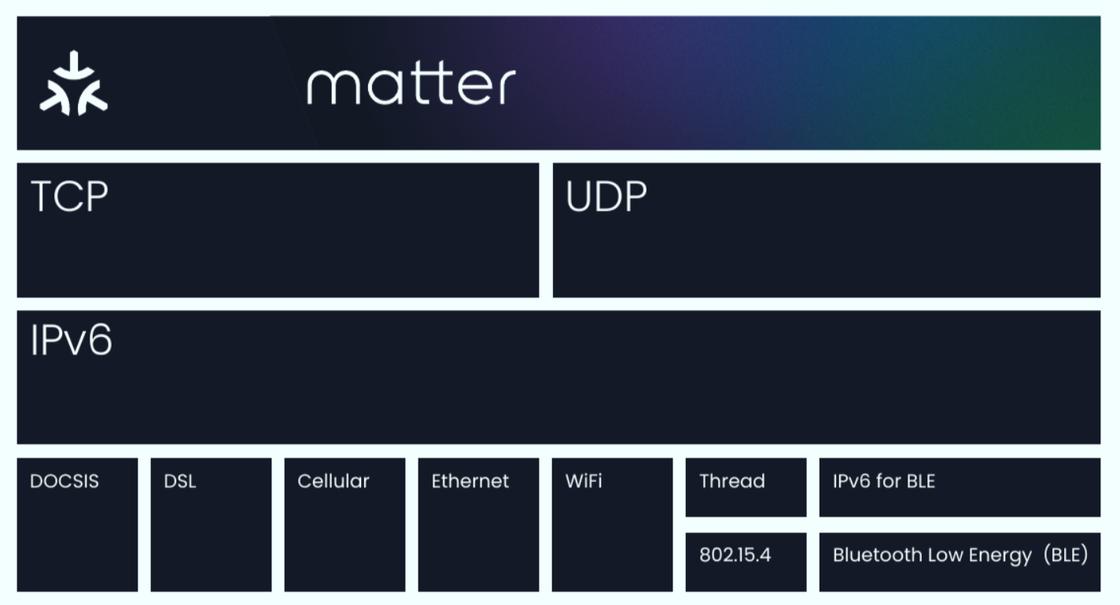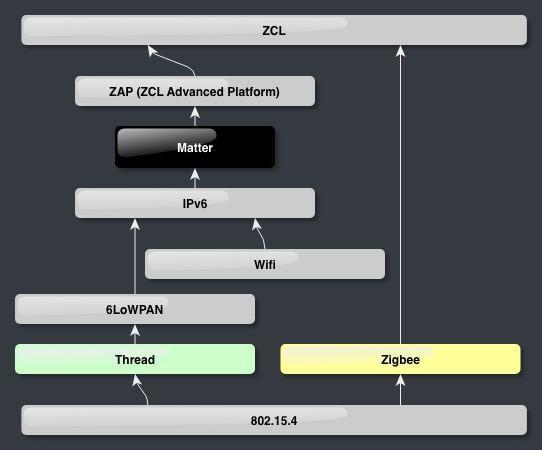Smart home solutions currently are still fragmented and interoperability can be only realized in limited scope. For absence of universal hardware standards or communication protocols in the whole industry, smart TVs, smart lights, smart refrigerators, and other devices from different manufacturers cannot be controlled and managed uniformly with a single central control system. With the release of the Matter standard, there will be an opportunity to change such awkward situation. The previous article briefly introduced the origin of Matter. Now we are to discuss in detail on Matter which was defined to converge various systems while keeping their own merits,and then unfold the prospect of future smart home systems.
What is Matter
Matter is an emerging standard of smart home systems, which aims to interconnect different smart home devices and eco systems so that they can interoperate in concert. Matter is the predecessor of the IoT connection standard "Project CHIP", which was worked out by Apple, Google, Amazon, and the Zigbee Alliance in the end of 2019. Later, it was officially renamed "Matter" in May 2021.

The biggest advantage of Matter is that it can realize interconnection and interoperability, making it easier to accelerate massive adoption of smart home systems. Users are no more bound by a single brand of smart home devices. Formerly, consumers who are going to purchase smart home devices are to check and ponder carefully with which smart home ecosystem they are to be compatible --Alexa, Apple HomeKit, Hey Google, or Smart Things, etc.. That makes the purchasing process extremely complicated.
For OEMs of smart home devices, their development must address the demand of parallelly supporting quite many smart home ecosystems to ensure peer-to-peer compatibility. That makes development difficult and costly. Matter makes interconnectivity and interoperability of devices much easier, thus lowers difficulty and cost of development.
Matter is a set of open standards which are free of royalty for OEMs. While releasing the Matter, the Zigbee Alliance officially renamed itself the Connection Standards Alliance (CSA) in hope of using a more generic name to attract more vendors to join the game. Matter has designed a universal device-pairing mechanism to allow users connect the device to a Wi-Fi network by scanning a QR code, swiping NFC, manually inputting a PIN code. The process is similar to that of HomeKit device registration, except that the HomeKit device uses Apple's proprietary communication protocol, while the Matter device uses a universal protocol. Each Matter device has a setting code, through which users can register it to different platforms, thus scaling obstacles between platforms. It means that users across different platforms can parallelly control household equipment. In scenario of voice control, they can use different brands of smart speakers to control devices in different rooms.
Matter is not only a protocol of interconnectivity, but also a kind of product certification. Its logo consists of three arrows pointing to the same center, representing the alliance of Apple, Google, and Amazon. Matter- compliant smart home devices will be tagged with this logo on their device bodies and packages in the future.
Constituents of Matter
At the top layer, Matter can be regarded as a language for communicating between smart home devices. As long as smart home devices use the language of Matter, they can communicate directly with each other without passing through the gateway. TCP/UDP is similar to different forms of mail and packages, which are sent to the house number (IPv6) of each smart home device through various transmission technologies (at the bottom). The underlying network technologies are similar to various express delivery methods. Their speed and stability may vary, but they all deliver mail to the corresponding number.

Thus, the role of Matter in smart home systems is extremely important. It provides a more convenient experience to users through converging different smart home devices for interoperability. It also benefits OEMs, because as long as they comply with Matter standard, an OEM can produce devices compatible with devices made by other vendors. That greatly reduces the development difficulty and cost.
What can Matter do
If you get a smart home device with Matter certification, then
From the beginning, Matter aims to unify the IoT market and enable OEMs to shift from the vicious competition of ecological monopoly building to benign competition focused on strength of products and insight to customer needs.
Thread and Matter
Thread protocol is a new communication protocol proposed by Nest in 2015. In the same year, Nest was acquired by Google. Therefore, when establishing Project CHIP, Google contributed Thread, an advanced low-power network protocol, as one of the cornerstones of Matter.

Ethernet, Wi-Fi, and Thread are the three main transmission protocols supported by Matter. Ethernet and Wi-Fi have been widely used in daily network connection and file transmission. Thread is more like Wi-Fi specially designed for smart home devices, with low power consumption, high coverage, and other features, which can keep battery-powered home devices running for many years. Compared with the low-power transmission protocols on the market, such as Zigbee and Bluetooth Mesh, Thread performs better in terms of bandwidth, stability, and response time. Whether in small and medium-sized networks or large-scale networks, the actual latency is far below the range that users can perceive. In addition, Thread also has features such as mesh, a self-healing network, and node automatic management.
How Matter realizes barrier-free communication in smart home
Matter inherits and strengthens the Zigbee Cluster Library (ZCL) of Zigbee Alliance, which has been accumulated for decades. Almost all devices in the market can use the cluster. Although ZCL was only applicable to Zigbee protocol at first, after the establishment of Matter, it was expanded into ZCL Advanced Platform (ZAP). All devices that support Matter will use ZAP as the only communication language for information exchange and control regardless of the communication mode used.

In the past, since the language of smart home devices is not uniform, gateways are needed for translation. For example, in the previous HomeKit, if you want to turn off a Zigbee switch, the instructions you send will be sent to the Zigbee gateway through HAP, and then translated into ZCL through the gateway to control the switch. However, after upgrading to Matter, the instructions you send can be directly transmitted to Wi-Fi, Ethernet, and Thread devices, and the device can be controlled without any intermediate device. Using the same language to communicate greatly improves availability and reduces costs.
What Steps Does Google, Amazon, Apple, Samsung Take for Matter
Revelation of Matter
Matter is a young protocol with history of only three or four years. However, it accumulates the essence of all smart home technologies in the past 20 years, so it has the fastest low-power transmission protocol in the market, the safest accession and operation modes, and the most comprehensive device type definition library. These excellent technologies equip Matter the competitive edge of enabling unity building in the IoT market.
The release of the Matter agreement had been delayed every year since the number of platforms that CSA needs to verify is far greater than expected. At present, more than 16 operating systems and chip set platforms pledge to support Matter. They include Linux, Darwin, Android, Tizen, Zephyr, and other operating system platforms, as well as chip set platforms from Infineon, Silicon Labs, TI, NXP, Nordic, Espressif Systems and Synaptics.
RF-star Technology launched the Matter modules
As a renowned wireless IoT solution vendor, Shenzhen RF-star Technology Co., Ltd. (RF-star) has launched several wireless communication modules that support the Matter protocol. They include Matter over Thread modules based on TI CC2652x7, Silicon Labs MG24, and Nordic nRF52840 SoCs, as well as the Matter over Wi-Fi modules based on TI CC3235S / CC3235SF SoCs, which can help customers quickly complete product development.
|
Photo |
Part Number |
IC |
Dimension |
|
|
RF-TI1352P2 |
CC1352P7 |
25.0 x 16.4 x 2.2 |
|
30.0 x 16.4 x 2.2 |
|||
|
|
30.0 x 16.4 x 2.2 |
||
|
CC2652P (with external flash) |
24.0 x 16.0 x 2.1 |
||
|
25 x 20.5 x 2.3 |
|||
|
20.5 x 17.5 x 1.7 |
|||
|
25 x 20.5 x 2.3 |
|||
|
20.5 x 17.5 x 1.7 |
|||
|
24.8 x 15.0 x 2.3 |
|||
|
24.8 x 15.0 x 2.3 |
|||
|
24.0 x 20.5 x 2.2 |
|||
|
|
RF-BM-MG24B1 |
EFR32MG24A410F1536IM48-B |
|
|
|
RF-BM-MG24B2 |
EFR32MG24A420F1536IM48-B |
|
About RF-star Technology
Shenzhen RF-star Technology Co., Ltd. (RF-star) is a high-tech company focusing on radio frequency devices and has been certified by Texas Instruments as a third-party IDH of low-power RF products for more than a decade. RF-star provides IoT wireless modules and a full set of solutions, including BLE, Wi-Fi, Matter, Wi-SUN, Sub-1G, ZigBee, Thread, etc. For more information, kindly visit the company website https://www.rfstariot.com/or contact us at info@szrfstar.com.